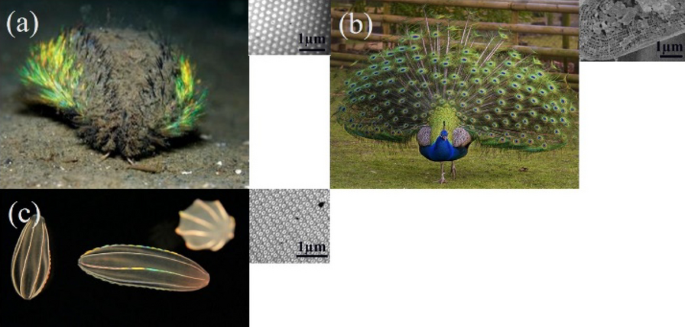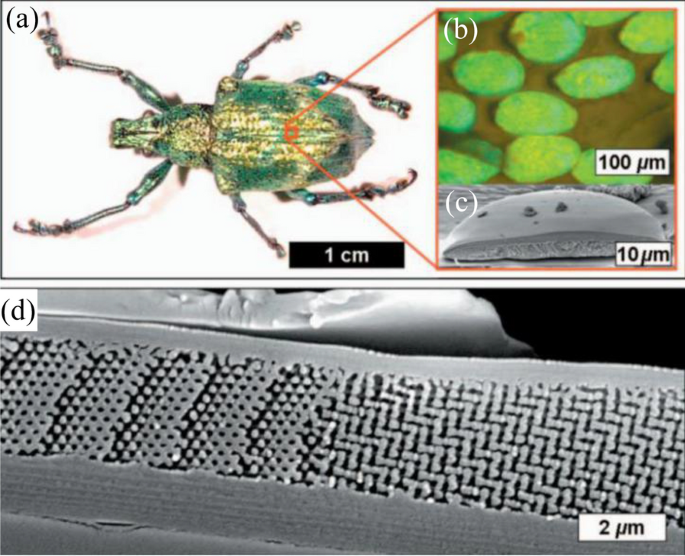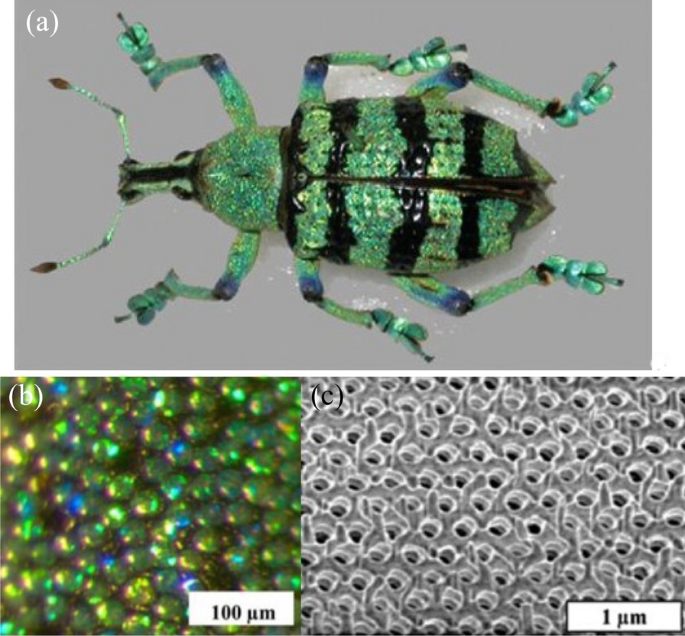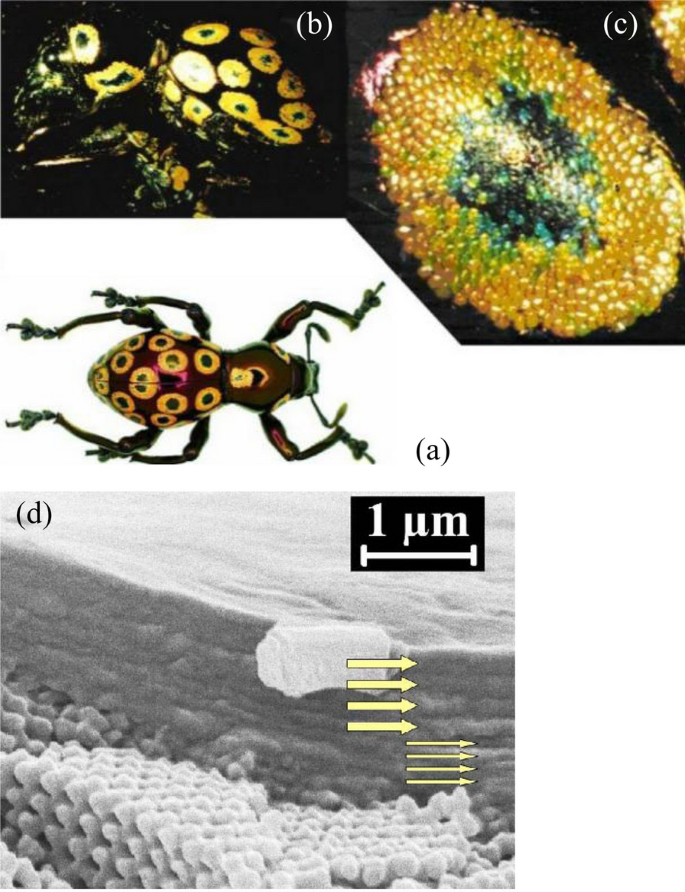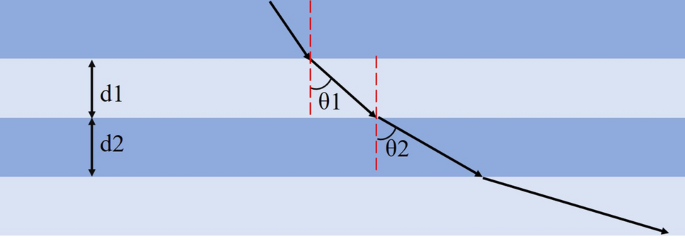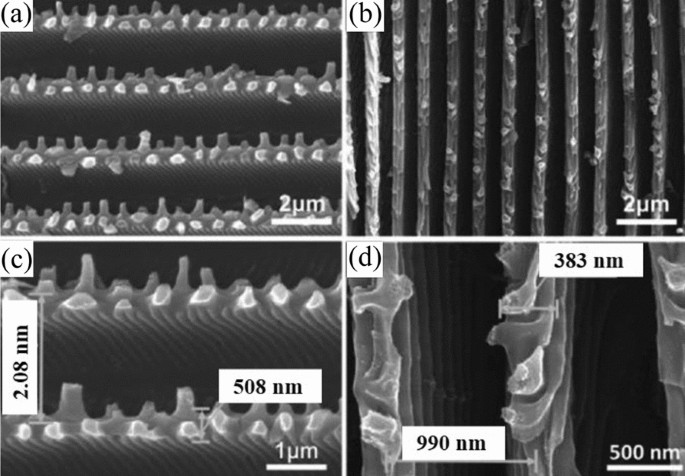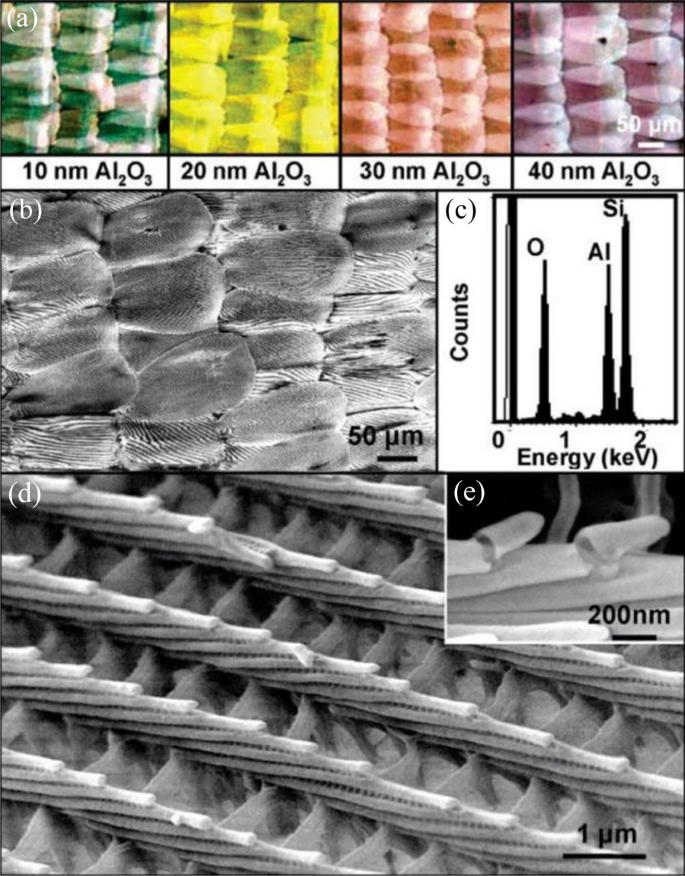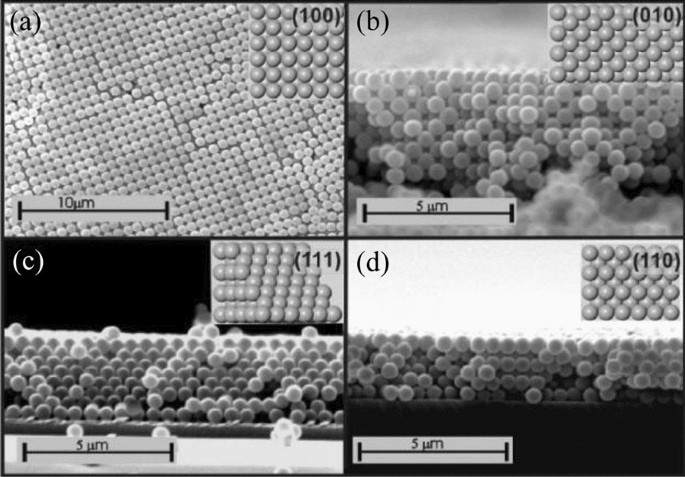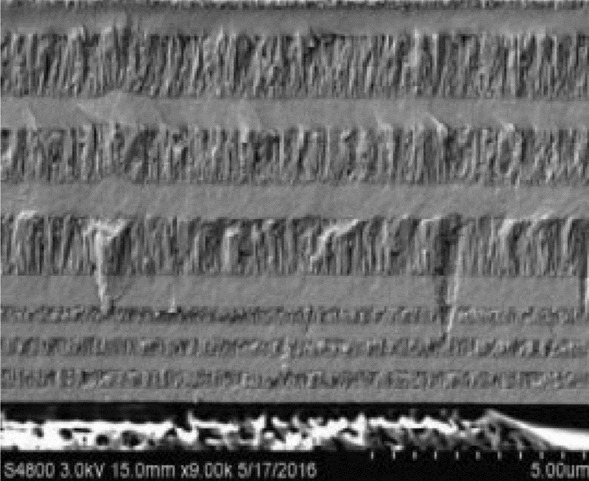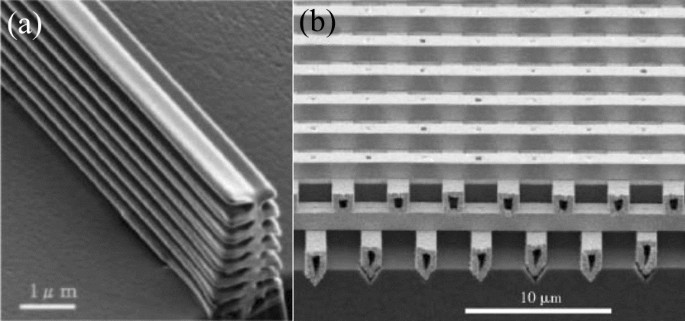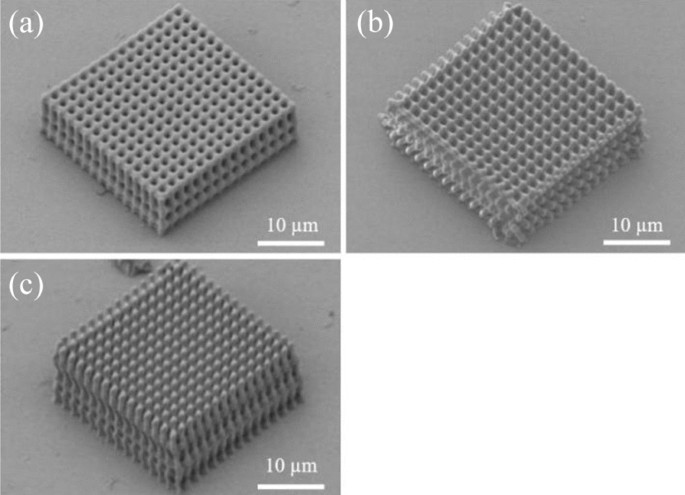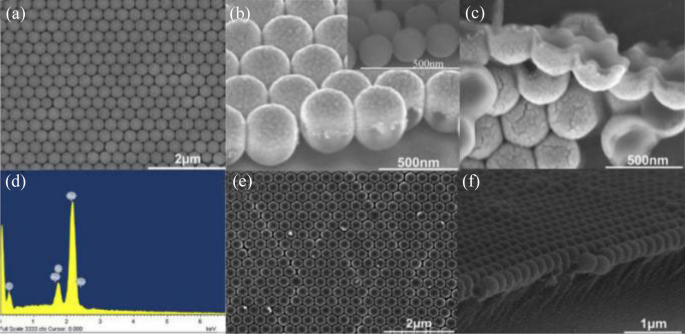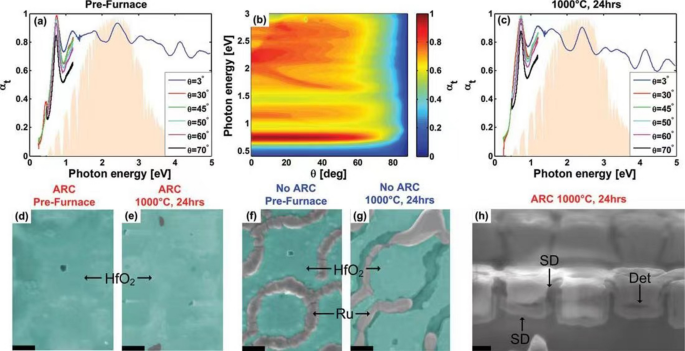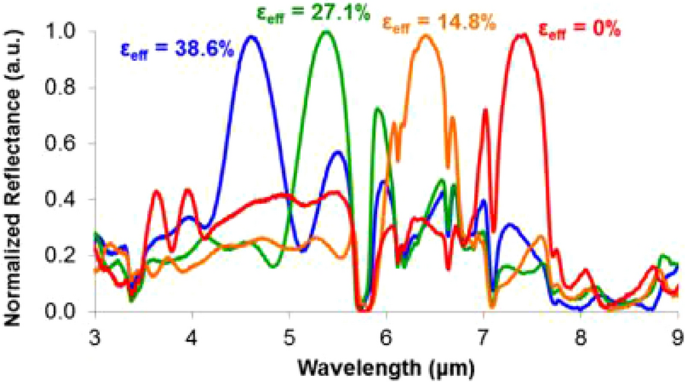- Review
- Open access
- Published:
Research Progress in Preparation and Application of Photonic Crystals
Chinese Journal of Mechanical Engineering volume 36, Article number: 39 (2023)
Abstract
Photonic crystals are periodic structural materials that have an impact on the propagation properties of photons. Due to their excellent optical, electrical and magnetic properties, their advantages and potential for applications in the above areas are gradually emerging. Therefore, an increasing number of researchers have focused on photonic crystals. In this paper, the characteristics of biological photonic crystal structures, such as those found in butterfly wings, sea mouse bristles, peacock feathers, melon jellyfish epidermal cells, and weevil exoskeletons, are described. The preparation methods of photonic crystals are systematically summarized (including the template method, self-assembly technology, electron beam evaporation coating technology, chemical vapor deposition technology, femtosecond laser two-photon technology, spin coating technology, and a variety of technology mixing), and the characteristics, advantages, and disadvantages of the different methods are compared. Furthermore, the development of photonic crystals in the field of sensors, solar cells, filters, and infrared stealth is discussed, demonstrateing the great development potential of photonic crystals. It is concluded that the realization of photonic crystals with high precision, high sensitivity, angle independence, and large-area uniform preparation is a key problem requiring urgent solution. Moreover, photonic crystals have potential development prospects in the fields of equipment stealth, new concept weapons, production, an daily life.
1 Introduction
For survival and adaptation in the natural environment, organisms evolve unique crystal structures in living organisms. Under visible light, these characteristic size structures exhibit bright colors [1, 2]. Most of these structures are composed of a complex mixture of biopolymeric compounds and proteins. They are found in the wings, feathers, and exoskeletons of organisms [3,4,5,6,7,8,9]. For example, a simple one-dimensional (1D) multilayer structure composed of alternating biopolymer layers with different refractive indices has been found in various butterfly wings and two-dimensional (2D) photonic crystal structures are found in bird feathers. In addition to these simple 1D and 2D structures, many Lepidoptera (beetles and butterflies) and Coleoptera (beetle) species display complex three-dimensional (3D) photonic crystal structures, whose lattice constants span the entire visible light region to give rise to beautiful colors [10]. These of materials with a 1D (Figure 1a), 2D (Figure 1b), and 3D (Figure 1c) periodic structures that constrain photon propagation called photonic crystals. Therefore, photonic crystals can act as both good insulators and conductors for electromagnetic waves. Photonic crystals combine band structure concepts in solid-state physics and electromagnetics; the behavior of light in a photonic crystal is controlled by Bragg diffraction and multiple scattering, resulting in various optical phenomena. Therefore, the Maxwell equations can be used with the plane wave expansion method [11], finite difference time domain method [12], and transmission matrix method [13] Thus, the conditions, localized states, reflectivity, and transmittance of the photonic crystal to produce the band gap structure can be calculated.
Since the concept of “photonic crystal” was proposed by Yablonovitch and John in 1987 [14, 15], researchers started to study the structure of photonic crystals and translate these theoretical concepts into practical applications. Biological systems provide templates to prepare photonic crystal structures. These photonic crystal structures are optimized to effectively interact with light and are successfully used in intelligent sensing, information dissemination, and other fields [16,17,18]. For example, Lee et al. [19] theoretically and experimentally proved that a 2D photonic crystal can be applied to a microcavity super-sensitive biosensor. Xiao et al. [20] developed an intelligent photonic crystal hydrogel material that can be used for real-time monitoring and removal of uranium ions (UO22+) through physical crosslinking, in which the photonic crystal array is fixed in a polyvinyl alcohol (PVA) hydrogel matrix and the diffraction wavelengths can be effectively adjusted in the visible region. A series of sensing materials that can quickly respond to various environmental stimuli, such as solvents, pH, and glucose, can be developed. The color changes produced by them are easily identifiable with the naked eye [21,22,23,24].
The diversity in biological photonic crystal structures has opened up a new avenue for research on photonic crystals. As they are composed of biopolymeric compounds, they lack some essential properties such as heat, light, and structural stability, which limits their application in emerging optics. Therefore, the application of advanced photons is limited.
To this end, this paper first summarizes the photonic crystal structures of butterflies, sea mice, peacocks, jellyfish, and weevils; subsequently, it introduces the causes of biological structural colors, so that the micro-nano structure of photonic crystals is fully understood. Then, the fabrication techniques of micro and nanostructured photonic crystals are described, their advantages and disadvantages are, and the applications of photonic crystal structures in optical materials are listed.
2 Biophotonic Crystal
2.1 Biophotonic Crystal Structure
There are many complex and fine natural photonic crystal structures that usually have special properties to meet the living needs of organisms. The main difference between each type of photonic crystal is its structure, which is divided into 1D, 2D, and 3D photonic crystal structures.
2.1.1 One Dimensional Photonic Crystal Structure
Most 1D photonic structures are multilayer or grating structures or their variants, having only periodic unidirectional structures. Brink et al. [25] studied the origin of abalone shell color. Their results indicate that the abalone shell surface has a multi-layer photonic crystal structure composed of alternate layers of inorganic aragonite and biological high polymer; light irradiates the microstructure of the inner shell producing an interference effect and bright structure color. A natural 1D photonic crystal structure can thus function as a simple multilayer structure or a complex 1D photonic crystal structures based on the changes in the structural details of multilayers.
The photonic crystal structure of a butterfly’s colorful wings has attracted much attention [26,27,28,29,30]. For example, the morpho butterfly shows a shining blue luster (Figure 2a). The detailed characteristics of the cross-sectional ultrastructure of the blue scales were observed in perpendicular to and parallel to the ridge vein, as shown in Figure 2b. The morpho butterfly presents a 1D multi-layer tower photonic crystal structure; this grating-like layered structure is the main reason for color generation. The section shape of Apatura laverna Leech is also a tower-like multilayer structure, as shown in Figure 2c, having purple light [31]. This reveals that the ratio of the 1D tower-shaped photonic crystal structure is different and the colors produced are also different. The section shape of the blue scales of Papilio maackii Menerries is shown in Figure 2d [32], and compared with the morpho butterfly, its color is relatively soft, because the reflectivity of a 1D pit-layered photonic crystal structure is relatively low. In addition, some fish also have 1D photonic crystal structure color, and their color changes with the environment. For example, fish neon tetra can change the structural color of its lateral stripe in response to a change in light conditions, from blue-green in the light-adapted state to indigo in the dark-adapted state [33]. The colors are produced by constructive interference of light reflected from stacks of intracellular guanine crystals, forming tunable photonic crystal arrays. The multilayer rainbow cell reflection plate, composed of a purine crystal structure, produces a spectral band system, which acts as an ideal 1D photonic crystal. If the external conditions change, the lattice constant changes, resulting in a color change.
2.1.2 Two Dimensional Photonic Crystal Structure
The 2D photonic crystal structure is generally composed of periodically arranged nanometer-scale slits, grooves, or columns. Parker et al. found the structure of rainbow-colored setae in sea mice (Figure 3a), which is a typical 2D photonic crystal structure composed of a hexagonal hollow cylindrical structure [34, 35]. There are also 2D photonic crystal structures in some bird feathers. For example, the peacock feather has a 2D cylindrical photonic crystal structure (Figure 3b) that strongly reflects a certain band of light along the direction of the skin, so the peacock opens the screen and presents a colorful [36,37,38]. The color change is related to the period length and the number of internal photonic crystal structures. Similarly, 2D photonic crystals also exist in some butterfly scales, and Vukusic et al. [39] studied the scales of the wings of the Papilio nirus and revealed a green principle using 2D photonic crystals. In the chitin matrix of the wing green scales of Papilio nirus, a 2D photonic crystal waveguide is formed by a 2D close-packed hexagonal air column structure. The forbidden band of the photonic crystal matches the fluorescence emission peak of the pigment in the scales of Papilio nirus. The incident light excites the pigment in the wing of the Papilio nirus, which causes the pigment to emit green light. The green emission light falls in the band gap of the 2D photonic crystal waveguide, so the green light is forbidden to propagate in the plane of the photonic crystal and can only propagate along the axial direction of the photonic crystal. Using this mechanism, the pigment emitted by green light effectively enhances the signal transmission between butterflies. Papilio bromius, P. epiphorbas, P. oribazus, and P. zalmoxis have this structure [40]. The above 2D photon structure is similar to the conventional 2D structure, and more complex 2D photon structures exist in nature. For example, the special rainbow color of the skin cells of melon jellyfish is produced by a 2D photon structure. Research shows that the structure is composed of slightly deformed hexagonal cilia, and each cilia is composed of finer microtubules, as shown in Figure 3(c). The refractive index of the microtubule is slightly higher than that of the outside world, and numerous such ciliated arrays produce a special rainbow color [41, 42].
2.1.3 Three Dimensional Photonic Crystal Structure
The propagation of light in a 3D photonic crystal structure also follows the characteristics of the photonic band system. These structures have a 3D dielectric constant in the range of the optical wavelength, which produces the structural color. The structural color of the weevil is composed of exoskeleton scales with a 3D photonic crystal structure [43]. In addition, each single scale is composed of a set of regions with different orientations of single crystal micron size, thus producing a macro color that is almost independent of the angle [44,45,46], its typical representative beetle is the weevil L. augustus. Figure 4a shows the dark green weevil L. augustus, whose angle-independent structural color comes from a single leaf-like cuticle scale on the bone (Figure 4b). A scanning electron microscope (SEM) image of the internal cuticle structure of the weevil L. augustus scales is shown in Figure 4c. Galusha et al. [47] used focused ion beam milling to randomly cross-cut weevil scales, and then used an electron microscope to observe them, as shown in Figure 4d. It was found that each scale was composed of different regions with unique crystal characteristics similar to the characteristic of a rectangular staircase, a spiral structure. Detailed analysis shows that the structure of these natural photonic crystals is based on the diamond lattice, which is the champion of the photonic crystal structure [48]. The weevil L. augustus selects a directional photonic crystal structure to produce a metallic luster color that is angle-independent, and mainly reflects green and yellow at a wide viewing angle, however, other colors are limited to special oblique angles [47]. However, compared with the weevil L. augustus, the weevil E. chevrolati has a dark yellow-green appearance and no metallic luster (Figure 5a). Its photonic crystal structure has intricate feature sizes and is a diamond photonic crystal structure with a lattice constant of several hundred nanometers. These photonic crystals were composed of exoskeleton scales in the micron region (Figure 5c). Nagi et al. [49] and the results show that a set of rainbow colors (Figure 5b) can be generated from red to orange, yellow, green, and blue by differently orienting each photonic crystal region. In the next layer of interaction, these different colored structures produce a yellow-green appearance that is independent of angle and the multilayer structure of the photonic crystal makes the color of this weevil possess no metallic luster. Welch et al. [50] studied the 3D photonic crystal structural color (Figure 6a, b, c) of Pachyrrhynchus congestus pavonius of the weevil by combining electron microscope, spectroscopy and numerical simulation, and the side structure of orange scales on its shell is shown in Figure 6d. It is a symmetrical, layered flat plate with a face-centered cubic lattice structure, and each crystal grain exhibits cubic symmetry centered on the face. The reflection wavelength was dominated by red and orange. The disordered photonic crystal structure introduced by the grain boundary makes it insensitive to the color change of the observation angle. In addition, there is also a butterfly with a 3D photonic crystal structure, such as the green scales of the yellow star green little gray butterfly, which show a rotating cuticle structure growing in different directions, which is a spiral 3D photonic crystal structure [51].
a Photograph of weevil L. augustus; b Optical micrograph of a single scale on the exoskeleton of L. augustus under white light; c Single-scale cross-sectional SEM image; d Detailed cross-sectional SEM image [47]
a Image of weevil E. chevrolati; b SEM image of exoskeleton color scales of weevil E. chevrolati; c SEM image of exoskeleton photon crystal structure of weevil E. chevrolati [49]
a and b Specimens of the weevil Pachyrrhynchus congestus pavonius; c Orange dots; d Orange microstructure [50]
2.2 Biological Color Development Mechanism
For abalone, butterflies, fish, birds, weevils, and other organisms in nature, their brilliant structural colors are mostly owing to the micro-nano photonic crystal structure of the exoskeleton. The light irradiation on the surface is caused by various optical effects. The main optical effects include various types of optical interference, scattering, and diffraction. The macroscopic performance is that the crystal reflects the color of visible light at a specific frequency, thereby generating a strong reflection peak [52,53,54,55]. As shown in Figure 7, taking the simplest multilayer film diffraction as an example, the Bragg diffraction formula of the band position of the photonic crystal is
where m is the diffraction order, \(\lambda_{Bragg}\) is the position of the Bragg reflection peak, D=dh+dl is the position of the belt, is the 1D photonic crystal structure period, dh and dl are the thicknesses of the high and low-refractive-index material layers, respectively, neff is the effective refractive index, θ is the incident angle, nh and fh, nl and fl are the refractive index and volume fraction of the high and low-refractive index regions, respectively.
From Eqs. (1) and (2), we can see that by controlling the refractive index (nh and nl), the incident angle (θ), and the thicknesses dh and dl of the high and low refractive index of the medium, respectively, the position of the Bragg reflection peak can be controlled such that the entire visible light region from red to purple can be obtained. Li et al. [56] observed that the internal structure of the abalone shell is a multilayer structure with a period length of 360 nm; the aragonite layer is approximately 330 nm; the refractive index n1≈1.6; the protein layer is approximately 30 nm; the refractive index n2≈1.3. When the light was incident perpendicularly, the reflection peak position was at 575 nm. If the interplanar spacing is approximately 365 nm, when N = 2, the reflection peak position at 570‒580 nm is consistent with the test results. However, the Bragg diffraction equation does not fully reflect detailed information on the band gap.
Therefore, to obtain more detailed information on the photonic band gap, the Maxwell equation needs to be used, which is expressed as
In Eq. (3), D, ρ, B, H, J, and E are the electric displacement vector, free charge density, magnetic induction intensity, magnetic field intensity, conduction current density, and electric field intensity, respectively. When the incident light frequency is ω (monochromatic), a typical eigenvalue equation can be obtained:
The operator Θ in the formula is given by
As can be seen from the above, the position of the diffraction peak can be affected by changing the period size of the photonic crystal or the refractive index of the composition. However, calculation software is required because of the complexity. Because the main features of the biophotonic crystal structure are finely graded, in addition to the basic color rendering principle, its diffraction characteristics will also have a more complex effect. For example, the ratios of 1D photonic crystal tower structures are different, and the structural colors presented are evidently different. In addition, the researchers also found that the color dependence of the 3D spiral photonic crystal structure of weevils is significantly weaker than that of simple 1D multilayer photonic crystal structures. Although there are numerous color development principles for biological photonic crystals, there are still many structural color development principles that need urgent study. To understand the properties and principles of biological structures, the corresponding structures need to be accurately prepared.
3 Preparation Method of Photonic Crystal
3.1 Biological Template Method
The biological template method is a synthetic technology in which the biological template is the main configuration, which when combined with various physical and chemical methods produces functional artificial products. It usually uses a combination of sol-gel technology, atomic layer deposition technology, high-temperature calcination, chemical etching, and biological photonic crystal regions as templates to prepare photonic crystal structures. Zhou et al. [57] used sol-gel technology to prepare lanthanum lead zirconate titanate (PLZT) raw liquor and the butterfly wings with photonic crystal structure were used as templates to press on the wet PLZT sol layer made by the spin-coating method. The liquid PLZT sol was filled into the gaps of these butterfly wing templates by capillary attraction, and the butterfly wing templates were removed by calcination. Finally, the photonic crystal structure of the butterfly wing of PLZT was successfully extracted.
Similarly, in Ref. [58], Papilio epiphorbas scales with photonic crystal structures are used as templates to prepare polycrystalline Y2O3:Eu3+ with a scale microstructure. The structure of bionic Y2O3:Eu3+ was characterized using field-emission scanning electron microscopy (SEM). It was proved that bionic Y2O3:Eu3+ can effectively extract the 2D photonic crystal structure of butterfly scales. Scholars of Jilin University [59] combined the sol-gel technology and chemical etching to form the SiO2 butterfly photonic crystal structure after gel solidification using the characteristic region of the Trogonoptera brookiana photonic crystal as a biological template, and the morphology and structure of the photonic crystal were characterized. The results show that the extracted tower structure is consistent with the height of the butterfly wing prototype, as shown in Figure 8. Peng et al. [60] adopted the sol-gel technique to use morpho butterfly as a template to copy the hematite with a photonic crystal structure (PC-α-Fe2O3) and obtained the required magnetophotonic crystal Fe3O4 (MPC-) by reducing PC-α-Fe2O3 Fe3O4). SEM X-ray diffraction, reflectivity measurement, and transmission electron microscopy results proved that the method's fidelity of structure replication has been confirmed on both the macro and micro levels, even as low as nanometers, and that the atomic layer deposition technology has good adaptability to the biophotonic crystal template.
SEM image of bionic micro nano structure of Trogonoptera brookiana butterfly wings [59]
Atomic layer deposition (ALD) technology has become another preparation technology that uses a biophotonic crystal structure as a template because of its precise deposition thickness control, good shape retention, uniformity, etc. [61]. Davy et al. [62] used the naturally formed structure on the wings of the P. blumei butterfly as a template and used low-temperature ALD of TiO2 to prepare the photonic crystal structure. The prepared photonic crystal structure has multiple layers of complexity. Huang et al. [63] used atomic layer deposition technology to uniformly coat Al2O3 on the scales of a large flash butterfly photonic crystal structure. The samples were annealed at 800 °C for 3 h under atmospheric conditions. At such a high temperature, the organic wings are completely burnt owing to the presence of oxygen. In this powerful template removal process, the large-scale arrangement of the fins and the nanoscale periodic structure were perfectly preserved, as shown in Figure 9 below.
An image of butterfly wing scales reproduced in alumina: a Optical microscope image of aluminum-coated butterfly wing scales; b Low-magnification SEM image of the aluminum oxide replica of butterfly wing scales; c Energy dispersive X-ray (EDX) spectrum of the alumina replica shown in b; d High magnification SEM image of alumina replica; e SEM image of two broken rib tips on alumina replica [63]
There are two main methods for the removal of biological template: high temperature calcination and chemical etching. the process of template removal should minimize the structural shrinkage and deformation and remove the template effectively and thoroughly to reduce the photon defect state. Based on the above template removal principle, Ref. [7] compares two methods of high temperature calcination and chemical etching. The results show that the feature size (shrinkage) of the extracted biological structure decreases isotropically when the biological template is removed by heat treatment; in contrast, the position of the reflection peak of the photonic crystal structure prepared by chemical etching technology is similar to that of the original biological photon structure.
The biological template method has many advantages, such as simplicity of operation, controllability of morphology, and wide applicability. However, the removal of the template not only increases the process flow number of steps but also easily destroys the nanostructure and properties of the samples; therefore, more preparation technologies for photonic crystal structures need to be explored.
3.2 Forming Technology
3.2.1 Preparation of Photonic Crystal Film Structure
The preparation of photonic crystal thin films mainly uses two techniques: self-assembly and electron-beam evaporation. Self-assembly refers to a technology in which basic structural units (molecules, nanomaterials, micron-or larger-scale substances) spontaneously form ordered structures. In the process of self-assembly, the basic structural units spontaneously organize or aggregate into a stable structure with a certain geometric appearance under interactions based on non-covalent bonds. Zhang et al. [64] prepared a 3D photonic crystal composed of 3.87 μm polystyrene microspheres [polystyrene (PS)] with ordered photonic forbidden bands in the infrared band through vertical substrate self-assembly technology as shown in Figure 10. Among them, sample No. 1# photonic crystal has a few point defects and line defects; sample No. 2# PS microspheres are all arranged regularly, and the prepared photonic crystal has only a few point defects or line defects. The middle PS ball has the best degree of order; sample No. 3# has many line defects for the arrangement, and the degree of orderly arrangement is the worst. The band is in the far-infrared band of 8–9 μm. The results show that the higher the degree of ordering of the microspheres and the larger the ordered area, the higher the reflectivity of the photonic crystal and the lower the emissivity; thus, it effectively suppresses infrared radiation on the target surface. The photonic crystal can effectively control the nanometer-level light waves. The structure of a hydrogel reverse opal (SHIO) photonic crystal prepared by self-assembly technology will be deformed by mechanical strain, so that the control of various wavelength optical waves can be accurately realized [65].
SEM images: 1# water, 2# ethanol: water = 2:8 (v%), and 3# ethanol: water = 4: 6 (v%) of the 3D photonic crystal (111) with opal structure prepared from different suspensions [64]
Spin coating is a type of self-assembly technology for film preparation with advantages of accurate and controllable film thickness, high cost performance, energy savings, and low pollution. The spin-coating process is mainly divided into three steps: glue dropping, high-speed rotation, and drying. In previous research [66], seven repeating cellulose, polyvinyl alcohol, and poly(N-vinylcarbazole) three-layer planar photonic crystal all polymer systems were fabricated using the spincoating technique. Transmission electron microscopy confirmed the existence of a multilayer structure, and its optical response can be explained theoretically. Mihi et al. [67] proposed a method for preparing colloidal crystal films using spin-coated colloids suspended in volatile solvents by dispersing the monodisperse precipitate in a volatile solvent (a mixture of ethanol, distilled water, and ethylene glycol) and obtains a strongly diffracted inverse opal photonic crystal structure within minutes without further processing. Figure 11 shows SEM images of the surface and cross section of the glass substrate upon spinning the colloidal SiO2 ball suspension. The results show that the quality of photonic crystals prepared using spincoating technology is greatly affected by the relevant parameters (i.e., particle concentration, relative concentration, and interface energy of each solvent in the dispersion medium)[68, 69].
SEM images of different crystal faces found in the top view and side view of [99] oriented silica colloidal crystal grown by spin coating (The crystal is made of silica dispersion in ethanol, which contains 30% particle volume fraction): a Top view corresponding to (100) planes; b Vertical (100) plane; c Inclined (111) plane and d Vertical (110) plane [67]
Photonic crystal thin films prepared by self-assembly technology have an orderly arrangement of molecules and high film-formation efficiency. However, each prepared film have defects, whose defects increase with an increase in the number of layers. Hence, only a specific molecular structure can achieve self-assembly, and the self-assembly binding force is relatively small. Electron beam evaporation coating is used to prepare the multilayer photonic crystal structure, where the kinetic energy of the evaporated particles is relatively large, which is conducive to enhancing the precision and binding force of the film.
Electron beam evaporation coating technology: In high vacuum, after the electron gun filament is heated, it emits hot electrons, which are accelerated by the anode, and obtain a large amount of kinetic energy to bombard the evaporated material, which transforms the kinetic energy into heat, so that the evaporated material is heated and gasified, and then the electron beam evaporation coating is realized. The energy source of electron beam evaporation can be highly concentrated, which causes the coating materials to evaporate at high temperatures. The evaporation rate of the coating material can be easily controlled by adjusting the power of the electron beam. Based on the characteristics of the “photon band gap” and “photon localization” of photonic crystals, scholars [70, 71] have designed a multi-layer structure of photonic crystals with stealth in the infrared band using the transmission matrix method. A multilayer photonic crystal structure was prepared using the electron-beam evaporation coating technology. During the plating process, the thickness of the film was monitored by quartz crystal monitoring. Relevant instruments are used to test and obtain the micro-section and reflection spectra (as shown in Figure 12). The results show that the microlayers of the prepared films are densely bonded and the reflection spectrum characteristics are in accordance with the theoretical design, which satisfies the small emissivity in the atmospheric window (3–5 μm) and far infrared (8–14 μm), and effectively suppress the mid- and far-infrared radiation, to achieve the stealth of the infrared band.
Cross section morphology of the photonic crystal sample cross section [71]
Electron beam evaporation coating technology is a relatively common technology in the industry for preparing multilayer photonic crystal structures. The kinetic energy of the evaporated particles is relatively large, which is conducive to the precision and binding force of the film. However, the cost of electron beam evaporation coating technology is relatively higher. When the coating machine is working, if the density of the steam near the evaporation source is relatively high, it will cause some interaction between the electron beam and the steam particles, which will affect the electron flux and make it off-track. In addition, it may cause the excitation and ionization of steam and residual gas, affecting the quality of the entire multilayer photonic crystal.
3.2.2 Preparation of Complex Photonic Crystal Structure
The preparation of photonic crystals with complex structures requires a higher preparation technology and more complicated processing conditions. For example, chemical vapor deposition (CVD) technology uses gaseous substances to produce chemical reactions and transport reactions on solids and generate solid deposits. It includes three steps: (1) formation of volatile substances, (2) transfer of the above substances to the deposition area, and (3) producing a chemical reaction on the solid to form a solid substance, and Keiichiro et al. [72, 73] used a Ga+ ion beam with a diameter of 7 nm to prepare a morpho butterfly-wing photonic crystal structure (Figure 13a) by combining the lateral growth mode with beam scanning. The reflection spectra of the butterfly scales and prepa red samples were measured using a spectrum analyzer system. The reflection spectra of the two were very similar. Studies have shown that the morpho butterfly photonic crystal structure can be prepared by focused ion beam CVD. Fleming et al. [74] selectively removed the silicon rod on the polysilicon/silicon dioxide structure that had been prepared, and backfilled tungsten by CVD to prepare a 3D all-metal photonic crystal with a wooden pile structure, as shown in Figure 13b. The structure has a strong suppression effect on thermal radiation in the far infrared band of 8.00–20.00 μm. CVD is relatively simple and more suitable for prepareation of photonic crystals and complex photonic crystal structures. However, the preparation efficiency is low causing environmental pollution.
Femtosecond laser two-photon polymerization technology, that is, a liquid polymer material absorbs two laser photons simultaneously in a very short time to undergo photopolymerization, thereby achieving two-photon polymerization manufacturing of microscale parts. Because of its inherent 3D manufacturing function and sub-diffraction limit spatial resolution, it is a very important micro-nano manufacturing technology. It has the advantages of 3D direct writing with any complex structure, no mask, and processing resolution that can break through the optical diffraction limit. Ren et al. [75] first designed cubic, body-centered, and face-centered photonic crystal structures, and then used femtosecond laser two-photon microfabrication polymers to successfully prepare a photonic crystal structure. The comparison of scanning SEMs of face-centered cubic lattice, cubic lattice, and body-centered cubic lattice shows that the face-centered cubic structure is more complex and the pores smaller, so it is not easy to process a relatively transparent structure (Figure 14). The 3D spiral photonic crystal structure of a soft spot butterfly prepared by femtosecond laser two-photon technology (that is, using a femtosecond (fs) laser with a wavelength of 800 nm as the writing beam) is superior in size, controllability, and uniformity [76, 77]. This preparation technology provides a unique tool for extracting 3D photonic crystal designs from nature. This process has the characteristics of rapid (1000 times faster than previous methods) and large-area preparation of nanoparticles. Nanoparticles are random and anisotropic [78]. The preparation of photonic crystals by femtosecond laser two-photon technology will become one of the most important and innovative technical methods in the field of optical precision micromachining. However, its processing efficiency is low with limited processing of large areas or batches; moreover, for specific complex structures, expensive devices, such as nano-stages, are required.
a Cubic; b Body center; c Face center lattice overall scanning electron micrograph (tilt 35°) [75]
CVD and femtosecond laser two-photon technology can effectively prepare complex photonic crystal structures. However, some photonic crystal structures require a variety of technologies to jointly prepare photonic crystals. Based on the wing characteristics of the blue tail butterfly, a combination of layer deposition techniques, including colloidal self-assembly, sputtering, and atomic layer deposition techniques, a multilayer photonic crystal structure with a periodic arrangement of butterfly scales was prepared [79], and five steps were required: (a) Polystyrene colloids were deposited on gold-plated silicon substrates. (b) Platinum or gold is grown in the gap of a colloidal array by electroplating. When the thickness of the deposited film is equal to the radius of the microsphere, the metal deposition stops. (c) Ultrasonic removal of polystyrene spheres from acetone. (d) Thin carbon film sputtering and atomic layer deposition have 11 alternating layers of TiO2 and Al2O3 (Figure 15a). The second method of (a), (b), (c) steps are the same as the first method, and then the colloids are molten to cover the cavities with a homogeneous film which is covered by a TiO2–Al2O3 multilayer (Figure 15b). This man-made structure can be used to encrypt cursor information on bank notes or other important items that need to be protected to avoid counterfeiting. Noda et al. [80] stacked the stripe of single-crystal III-V semiconductor (GaAs or InP) to form photonic crystal, preparation steps are as follows: A pair of striped wafers were first fused at 700 ℃ and cross configured, then one of the substrates was removed by a combination of chemical and dry etching. Thus, a pair of chips with two stacked stripe layers are stacked again by chip fusion technology, so that two parallel stripes are shifted for half a period, and the structure is constructed by a laser beam assisted alignment method. Finally, a complete 3D photonic crystal with an accuracy of 30 nm was obtained by using a variety of techniques to mix and stack the 0.7 μm periodic semiconductor fringes; however, this method is complex, time-consuming, and expensive to prepare photonic crystals.
SEM images of the holes covered by conformal multilayer stacks of 11 alternating layers of titanium and alumina: a Method 1 cross-sectional view; b Method 2 cross-sectional view [79]
The research goal of biomimetic photonic crystals has gradually expanded from scientific theory to engineering technology. Each preparation method has its own advantages and disadvantages, as listed in Table 1 below. With advancement in research, numerous innovative preparation methods for biomimetic photonic crystals are emerging. To prepare a variety of photonic crystal structures, it is necessary to improve the preparation methods to solve processing defects and achieve affordability. This can greatly promote the use of photonic crystal optical devices.
4 Application of Photonic Crystal
The photonic band gap of the photonic crystal does not depend on the angle adjustment to realize the characteristics of the photonic crystal to suppress or enhance the radiation of the specific band of the object. This characteristic has been successfully applied to sensors, filters, solar cells, infrared stealth, and other fields. At present, this research is in its nascent stage and will become a hot topic in future.
4.1 Sensor
The photonic band gap in the photonic crystal is adjustable and can be used to detect the mechanical force [81, 82], temperature [83, 84], solvent concentration [85, 86], and other multifunctional sensors. Its working principle is as follows: when the parameters (mechanical force, temperature, etc.) detected by the sensor change, the structural parameters (such as refractive index and crystal surface spacing) of the photonic crystal will also change correspondingly, which will cause the band gap position of the photonic crystal to shift, and the information of the change in the detection parameters can be determined. The literature [87] used the characteristics of photonic crystal point defects to theoretically prove that photonic crystals can be used to fabricate pressure-sensing materials. Men et al. [88] attached an Au nanosphere array to a polyacrylic acid (PAA) hydrogel membrane to prepare an independent 2D Au nanosphere array/hydrogel composite sensor membrane, as shown in Figure 16. These Au nanospheres/hydrogel composite membranes exhibit visually diffractive and stronger diffraction intensities owing to the periodic structures and large cross sections of Au nanospheres. The proposed strategy can be extended to various functional hydrogel membranes and the development of different visual sensors [89,90,91]. Scholars [92] have proposed the use of a photonic crystal nanobeam cavity (PCNC) to realize Fano resonance, which provides a theoretical reference for the design of nano-sensor devices.
a Top view of SEM image of 2D PS colloidal crystal with gold nanoshell; b Cross-sectional view of SEM image of image a, (inset: SEM image of PS colloidal crystal); c SEM image of gold nanoshell after dissolving PS microspheres in methylene chloride; d EDS analysis of Au nanoshell; CAuHCF SEM image top view: e Image and f Cross-sectional view [88]
4.2 Solar Battery
Photonic crystals can be used to obtain solar cells with different structural colors, which reduces the angle dependence of the structure colors [93]. Structural color solar cells increase the reflection of light, reduce the internal heat intake and temperature, and improve the efficiency of the battery. With the energy crisis looming, the development and utilization of solar energy has gradually become the focus of researchers, and the selective absorption of sunlight plays a key role in the energy conversion of solar thermal photovoltaics (STPVs). The selective absorption of solar energy requires that materials have good selectivity for solar light in the solar spectrum, excellent high-temperature resistance, and omnidirectional absorption [94,95,96]. Zhang et al. [97] applied a 1D photonic crystal to a solar cell, using a porous 1D photonic crystal instead of a multi-empty frame layer in the solar, and the results indicated that the method could prepare solar cells with different structural colors. 2D metal air photonic crystals (MAPC) can selectively absorb near-infrared light through the cavity mode and can withstand a high temperature of 1000 °C. However, the receiving angle is limited to ±30°, and the absorption in the visible spectrum is limited due to diffraction. Chou et al. [96] developed a 2D metal dielectric photonic crystal (MDPC) structure, and demonstrated broadband absorption, full angle absorption, wafer-level manufacturing, and high-temperature robustness, as shown in Figure 17. The MDPC made at the wafer level has 85% measurement absorption for a 0.7‒5 eV photon energy. The high-temperature test at 1000 °C for 24 h showed good optical performance. The MDPC structure selection absorber has the ideal characteristics of large-scale and effective conversion of solar energy into electrical energy.
Wide angle high temperature analysis of MDPhC: a Before the furnace test, the absorption spectra of different angles were measured at room temperature; b RCWA simulates the contour plot of the absorption spectrum as a function of incident angle 8; c The absorption spectra of the arc sample stored in a furnace at 1000 ℃ for 24 h correspond to its SEM images obtained d before and e after the furnace test (Note that the ring is no longer visible due to the arc layer); SEM images of non-arc samples f before and g after; h SEM of section FIB of arc sample after furnace test (Degradation caused by metal surface diffusion (SD) and debonding (DET) showed that all scales were 200 nm) [96]
Solar cells with photonic crystal structures greatly improve the efficiency of solar energy, which can accurately control the light scattering, reflection, and absorption of different colors.
4.3 Wave Filter
Under certain conditions, the photonic crystal waveguide and microcavity are coupled, and the light wave energy in the waveguide near the resonant frequency of the microcavity will be “downloaded” into the microcavity, that is, the photonic crystal demonstrate filtering characteristics [98]. A filter with a 1D photonic crystal structure has the simplest form. Tang et al. [99] designed a 1D photonic crystal filter using the transfer matrix method. They mainly analyzed two factors of the transmissivity of 1D photonic crystals with defect layers F and A(BA)NF(AB)MA: the thickness ratio of A to B and the intermediate defect layer. The thickness ratio of A to B and the influence of the middle defect layer on the transmissivity were studied by computer simulation. The design method for a 1D photonic crystal filter is given. Pavlichenko et al. [84] alternately spin-coated TiO2 and SiO2 nanosols on a glass substrate to construct a responsive optical filter based on inorganic materials. This material responds to temperature based on changes in the moisture content of the photonic crystal structure and thermo-optic effects. The photonic crystal filter mainly focuses on the local cropping characteristics of the photonic crystal quantum well for light, and has a positive guiding value for the design and manufacture of high-quality optical filter devices. Su et al. [100] used the transfer matrix method to study the filtering quality of single-barrier and double-barrier 1D photonic crystal quantum well filters. The results show that the filtering quality of photonic crystal quantum well filters affects the refractive index of the barrier medium. Chen et al. [98] proposed a novel 2D photonic crystal terahertz filter with a high transmission efficiency. The filter has a novel structure, narrow bandwidth, and high efficiency, and can be used as a frequency selection filter for terahertz-band photonic crystals.
The filter is an important device for terahertz technology applications. Developing a terahertz filter with good performance and easy integration is an important research focus. Compared with traditional filters, photonic crystal filters have smaller size and better performance.
4.4 Infrared Stealth
As photonic crystals can suppress or enhance the radiation of specific wavelength bands of objects, they can provide new avenues for the development of stealth materials and applications in the field of infrared stealth. Liu et al. [71] designed and prepared a mediumand far-infrared dual-band stealth-compatible photonic crystal film using the transmission matrix method and the evaporation coating process. The actual thickness of the photonic crystal film and the reflectance of the mid- and far-infrared spectra were measured, and the results agreed with the theoretical calculations. This shows that compared with two traditional infrared stealth materials, infrared stealth coating and conventional camouflage cloth, the photonic crystal film has the strongest ability to suppress infrared radiation in the mid- and far-infrared dual-band. Zhang et al. [64] prepared ordered 3D photonic crystals with photonic forbidden bands in the infrared band using the vertical substrate self-assembly method. The results show that the higher the degree of ordering of the microspheres and the larger the ordered area, the higher the reflectivity of the photonic crystal and the lower the emissivity thus the higher the effective suppression of infrared radiation on the target surface. Zhang et al. [101] successfully prepared SiO2 colloidal opal-type photonic crystal materials with forbidden bands of 2.8–3.5 μm and 8–10 μm. The material can change the infrared radiation characteristics of the corresponding wave band of the target and has the stealth effect of the target infrared wave band. Wang et al. [102] prepared infrared stealth materials using a 1D double-heterophotonic crystal structure and realized extremely high reflectivity of the materials at 3–5 μm and 8–14 μm. The infrared radiation intensities at 3–5 μm and 8–14 μm were 0.073 and 0.042, respectively. At present, the technology of infrared stealth gradually tends to control and adjust the temperature or emissivity materials composed of sensitive units, and the infrared radiation characteristics of the object being detected can be automatically adjusted with the environment to achieve reunification of the infrared radiation characteristics of the target and environment, elimination of the target and background infrared characteristics of the differences, camouflage screen, and stealth. Hurtado et al. [103]. synthesized thermally controllable VO2 nanoparticles in a photonic crystal, and obtained an adaptive material with reversible temperature adjustment in the mid-infrared band. The phase transition and refractive index of VO2 are regulated by temperature change, and the position and width of the photon gap are regulated to achieve infrared stealth. Chernow et al. [104] used polymer nanolattices of octahedral unit cells to mechanically prepare tunable 3D photonic crystal materials, realizing a wide range of near-infrared and mid-infrared tunability of spectral characteristics. The material has a strong reflection peak in the mid-infrared band, and the position of the reflection peak reversibly moves over a large range under uniaxial pressure. When a compression of 38.6% is applied to the material, the position of the forbidden band will be moved from 7.3 μm to 5.1 μm (see Figure 18). With advances in research of photonic crystals, it is expected to realize multi-functional intelligent stealth materials of infrared, radar and visible light in the military field.
Reflectance spectra corresponding to different compression ratios [103]
Photonic crystals are a new type of artificial functional material. Its photonic bandgap has high reflectivity to the incident electromagnetic wave, which can effectively change the radiation characteristics and reduce the detectability of the target in the infrared band. This is the key development direction of infrared stealth technology in the future.
A photonic crystal structure can achieve a high propagation speed and high frequency with no interaction. This has advantages in sensors, solar cells, filters, and infrared stealth applications [105, 106]. In addition, photonic crystals have applications in cosmetics, jewelry, clothing, and other fields [107].
5 Conclusions and Prospects
Bionic technology is a rapidly developing field. The foundation of this technology inspired by natural development. Biological photonic crystals have special control properties for electromagnetic waves, which provide ideas for the optimization, preparation, and application of photonic crystal structures. However, most biophotonic crystals are regulated only by visible light. Therefore, further research is needed to regulate the photonic crystals at other wavelengths, such as ultraviolet, infrared, and microwave. Among them, the preparation of photonic crystals is the key to breaking through the application of photonic crystals. At present, the main technologies for preparing photonic crystals include the template method, self-assembly technology, electron beam evaporation coating technology, chemical vapor deposition technology, femtosecond laser two-photon technology, spin coating, and various technology combinations. Different preparation techniques have their own advantages and disadvantages. There are also limitations in the preparation of large-area, high-quality, defect-free, low-cost, and full-bandgap photonic crystals. Therefore, it is necessary to achieve perfection in preparation technology of photonic crystals which will enhance the photonic crystal strengths and avoid its weaknesses, so that photonic crystals can play an important role in applications.
Photonic crystal science and technology is a very fast developing and important field that involves many subjects and has a very rich scientific connotation. Owing to the limitations of current preparation technology, the development of photonic crystals is still in the exploratory stage, and theoretical research is needed for in-depth and expanding study. With the in-depth study of photonic crystals, some new properties that photonic crystals may have will be further explored. In the future, photonic crystals will become research hotspots in the fields of sensors, solar cells, filters, infrared stealth, etc., where higher requirements are placed on the reusability, sensitivity, and rapid response to environmental parameters of photonic crystal materials. In addition, the combination of photonic crystals with other new materials and new functions will also open up new fields for research of photonic crystals, such as self-healing materials with photonic crystal characteristics and other aspects of research that are yet to be explored. Furthermore, the existing technology mostly constructs photonic crystals within a small size range, and achieving uniform preparation over a large area is also a problem to be solved. Reducing its angle dependence is also a subject worth studying.
References
P Vukusic, J R Sambles. Photonic structures in biology. Nature, 2003, 424(6950): 852-855.
L Feng, B Dong, F Zhao, et al. Ultranegative angular dispersion of diffraction in quasiordered biophotonic structures. Optics Express, 2011, 19(8): 7750-7755.
D Christian, D C Skigin, M E Inchaussandague, et al. Structural color in the swallow tanager (tersina viridis ): Using the korringa-kohn-rostoker method to simulate disorder in natural photonic crystals. Physical Review E, 2018, 98(3): 032403.
M Imafuku, Y Hirose, T Takeuchi. Wing colors of chrysozephyrus butterflies (lepidoptera;lycaenidae): Ultraviolet reflection by males. Zoological Science, 2002, 19(2): 175.
D Yong, X Sheng, L W Zhong. Structural colors from Morpho peleides butterfly wing scales. Journal of Applied Physics, 2009, 106(7): 1679.
J P Vigneron, J F Colomer, M Rassart, et al. Structural origin of the colored reflections from the black-billed magpie feathers. Physical Review E, 2006, 73(2 Pt 1): 021914.
J W Galusha, L R Richey, M R Jorgensen, et al. Study of natural photonic crystals in beetle scales and their conversion into inorganic structures via a sol–gel bio-templating route. Journal of Materials Chemistry, 2010, 20(7).
Z Jia, M Fernandes, Z Deng, et al. Microstructural design for mechanical-optical multifunctionality in the exoskeleton of the flower beetleTorynorrhina flammea. Proceedings of the National Academy of Sciences of the United States of America, 2021, 118(25).
J Zi, X D Yu, Y Z Li, et al. Coloration strategies in peacock feathers. Proc. Natl. Acad. Sci. U S A, 2003, 100(22): 12576-12578.
P Frank, H Michael. Photonic structures in biology: A possible blueprint for nanotechnology. Nanomaterials and Nanotechnology, 2014, 4(1):1.
K M Ho, C T Chan, A Soukoulis. Existence of a photonic gap in periodic dielectric structure. Physical Review Letters, 1990, 65(25): 3152-3155.
A Lavrinenko, P Borel, L Frandsen, et al. Comprehensive FDTD modelling of photonic crystal waveguide components. Optics Express, 2004, 12(2): 234-248.
J Pendry, A Mackinnon. Calculation of photon dispersion relations. Physical Review Letters, 1992, 69(19): 2772-2775.
E Yablonovitch. Inhibited spontaneous emission in solid-state physics and electronics. Physical Review Letters, 1987, 58(20): 2059-2062.
S John. Strong localization of photons in certain disordered dielectric super lattices. Physical Review Letters, 1987, 58(23): 2486-2489.
J Sajeev. Why trap light. Nature Materials, 2012, 11(12): 997-999.
E Yablonovitch. In the limelight: Interview by Kosmas Tsakmakidis. Nature Materials, 2012, 11(12): 1000-1.
Y J Zhao, Z Y Xie, H C Gu, et al. Bio-inspired variable structural color materials. Chemical Society Reviews, 41(8): 3297-0.
M R Lee, P M Fauchet. Two-dimensional silicon photonic crystal based biosensing platform for protein detection. Optics Express, 2007, 15(8): 4530-0.
F Xiao, Y Sun, W Du, et al. Smart photonic crystal hydrogel material for uranyl ion monitoring and removal in water. Advanced Functional Materials, 2017, 27(42): 1702147.1-1702147.7.
C Chen, Z G Zhu, W H Shih, et al. Facile preparation and self-assembly of monodisperse polystyrene nanospheres for photonic crystals. Journal of Nanoscience & Nanotechnology, 2015, 15(4): 3239-3243.
C Chen, X L Zhao, Z H Li, et al. Current and emerging technology for continuous glucose monitoring. Sensors, 2017, 17(1): 182.
Xuemin Chen. Molecularly imprinted hollow spheres for the solid phase extraction of estrogens. Talanta: The International Journal of Pure and Applied Analytical Chemistry, 2015, 140: 68-72.
F Xue, S A Asher, Z Meng, et al. Two-dimensional colloidal crystal heterostructures. RSC Advances, 2015, 5(24): 18939-18944.
D J Brink, N Berg, A J Botha. Iridescent colors on seashells: An optical and structural investigation of helcion pruinosus. Applied Optics, 2002, 41(4): 717-722.
F Y Zhang. Infrared detection based on localized modification of morpho butterfly wings. Advanced Materials, 2015, 27(6): 1077-1082.
S C Niu, B Li, J F Ye, et al. Angle-dependent discoloration structures in wing scales of morpho menelaus butterfly. Science China Technological Sciences, 2016, 59(5): 749-755.
M Azadeh Didari. A biomimicry design for nanoscale radiative cooling applications inspired by Morpho didius butterfly. Scientific Reports, 2018, 8(1): 1-9.
Z W Han, L Y Wu, Z M Qiu, et al. Microstructure and structural color of butterfly scales. Chinese Science Bulletin, 2008(22): 2692-2696.
J Q He, Nicolò SimoneVilla, Z Luo, et al. Integrating plasmonic nanostructures with natural photonic architectures in Pd-modified Morpho butterfly wings for sensitive hydrogen gas sensing. RSC Advances, 2018, 8(57): 32395-32400.
H Y Guan. Study on the color formation mechanism and microstructure of typical butterfly scales. Changchun: Jilin University, 2007. (in Chinese)
L Q Ren, Z M Qiu, Z W Han, et al. Experimental study on the photochromic Mechanism of the structure of greenbelt butterflies. Science in China (Series E: Technical Science), 2007(07): 952-957. (in Chinese)
D Gur, B A Palmer, B Leshem, et al. The mechanism of color change in the neon tetra fish: A light‐induced tunable photonic crystal array. Angewandte Chemie, 2015, 127(42).
G Tayeb, B Gralak, S Enoch. Structural colors in nature and butterfly-wing modeling. Optics & Photonics News, 2003, 14(2): 38-43.
A R Parker, R C Mcphedran, D R Mckenzie, et al. Photonic engineering-Aphrodite’s iridescence. Nature, 2001, 409(6816): 36-37.
J Zi, X D Yu, Y Z Li, et al. Coloration strategies in peacock feathers. Proceedings of the National Academy of Sciences of the United States of America, 2003, 100(22): 12576-12578.
Z l Ni. Revealing the beauty of the peacock. World Science, 2004(01): 31.
Y Z Li. Study on color of biological structure and artificial structure. Shanghai: Fudan University, 2005. (in Chinese)
P Vukusic. Directionally controlled fluorescence emission in butterflies. Science, 2005, 310(5751): 1151.
T M Trzeciak, B D Wilts, D G Stavenga, et al. Variable multilayer reflection together with long-pass filtering pigment determines the wing coloration of papilionid butterflies of the nireus group. Optics Express, 2012, 20(8): 8877-8890.
V Welch, J P Vigneron, V Lousse, et al. Optical properties of the iridescent organ of the comb-jellyfish Bero cucumis (Ctenophora). Physical Review E, 2006, 73(4): 041916.
V L Welch, J P Vigneron, A R Parker. The cause of colouration in the ctenophore Beroe cucumis. Current Biology, 2005, 15(24): R985-R986.
J X Chen, J Xie, Z S Wu, et al. Review of beetle forewing structures and their biomimetic applications in China: (I) On the structural colors and the vertical and horizontal cross-sectional structures. Materials Science and Engineering: C, 2015, 55: 605-619.
C Pouya, D G Stavenga, P Vukusic. Discovery of ordered and quasi-ordered photonic crystal structures in the scales of the beetle Eupholus magnificus. Optics Express, 2011, 19(12): 11355-11364.
M Johannes, D V Opdenbosch, W Xia, et al. Fabrication of three-dimensional photonic crystals with tunable photonic properties by biotemplating. Photonics and Nanostructures - Fundamentals and Applications, 2012, 10(4): 516-522.
B D Wilts, K Michielsen, H D Raedt, et al. Hemispherical Brillouin zone imaging of a diamond-type biological photonic crystal. Journal of The Royal Society Interface, 2011, 9(72): 1609-1614.
J W Galusha, L R Richey, J S Gardner, et al. Discovery of a diamond-based photonic crystal structure in beetle scales. Physical Review E, 2008, 77(5):050904.
M Maldovan, E L Thomas. Diamond-structured photonic crystals. Nature Materials, 2004, 3(9): 593-600.
R K Nagi, D E Montanari, M Bartl. Photonic crystal micro-pixelation and additive color mixing in weevil scales. Bioinspiration & Biomimetics, 2018, 13(3): 035003.
W Victoria, L Virginie, D Olivier, et al. Orange reflection from a three-dimensional photonic crystal in the scales of the weevil Pachyrrhynchus congestus pavonius (Curculionidae). Physical Review E Statistical Nonlinear & Soft Matter Physics, 2007, 75(4 Pt 1): 041919.
B Schuetrumpf, M A Klatt, K Iida, et al. Appearance of the Single Gyroid Network Phase in Nuclear Pasta Matter. Physical Review C, 2014, 91(2): 025801.
L Poladian, S Wickham, K Lee, et al. Iridescence from photonic crystals and its suppression in butterfly scales. Journal of the Royal Society Interface, 2009, 6(Suppl_2): S233-S242.
D J Brink, M E Lee. Ellipsometry of diffractive insect reflectors. Applied Optics, 1996, 35(12): 1950-1955.
S Kinoshita, S Yoshioka, K Kawagoe. Mechanisms of structural colour in the Morpho butterfly: Cooperation of regularity and irregularity in an iridescent scale. Proc. Biol. Sci., 2002, 269(1499): 1417-1421.
S Yoshioka, S Kinoshita. Wavelength-selective and anisotropic light-diffusing scale on the wing of the Morpho butterfly. Proceedings Biological Sciences, 2004, 271(1539): 581-587.
B Li, J Zhou, L T Li, et al. One-dimensional photonic band gap structure in abalone shell. Chinese Science Bulletin, 2005, 050(013): 1422-1424. (in Chinese)
B Li, J Zhou, R Zong, et al. Ordered ceramic microstructures from butterfly bio-template. Journal of the American Ceramic Society, 2006, 89(7): 2298-2300.
K L Yu, T X Fan. Biomimetic fabrication of 2D photonic Y_2O_3:Eu~(3+) phosphor templated from butterfly wing scales. Journal of Shandong University (Engineering Science Edition), 2012, 042(001): 121-126.
Z Z Mu. Bionic functional surface design, Manufacturing and Performance Research based on typical butterfly wings. Changchun: Jilin University, 2019. (in Chinese)
W H Peng, S M Zhu, W L Wang, et al. Spectral selectivity of 3D magnetophotonic crystal film fabricated from single butterfly wing scales. Nanoscale, 2014, 6(11): 6133-6140.
C J Summers, D P Gaillot, M Crne, et al. Investigations and mimicry of the optical properties of butterfly wings. Journal of Nonlinear Optical Physics & Materials, 2010, 19(03): 489-501.
D P Gaillot, P O De, V Welch, et al. Composite organic-inorganic butterfly scales: Production of photonic structures with atomic layer deposition. Physical Review E Statistical Nonlinear & Soft Matter Physics, 2008, 78(3): 031922.
J Huang, X Wang, Z L Wang. Controlled replication of butterfly wings for achieving tunable photonic properties. Nano Letters, 2006, 6(10): 2325-2331.
R R Zhang, G H Qiu, J Han, et al. Preparation of three-dimensional ordered photonic crystals and its infrared stealth performance. Journal of Infrared and Millimeter Wave, 2017, 36(06): 739-743.
K Min, S Kim, S Kim. Deformable and conformal silk hydrogel inverse opal. Proceedings of the National Academy of Sciences, 2017, 114(24): 6185-6190.
G Manfredi, C Mayrhofer, G Kothleitner, et al. Cellulose ternary photonic crystal created by solution processing. Cellulose, 2016, 23(5): 1-10.
A Mihi, M Ocaña, H Míguez. Oriented colloidal‐crystal thin films by spin‐coating microspheres dispersed in volatile media. Advanced Materials, 2006, 18(17): 2244-2249.
E Allahyarov, I D'Amico, H Löwen. Effect of geometrical confinement on the interaction between charged colloidal suspensions. Physical Review E, 1999, 60(3): 3199.
D J Taylor, D P Birnie. A case study in striation prevention by targeted formulation adjustment: aluminum titanate solgel coatings. Chemistry of Materials, 2015, 14(4): 1488-1492.
J K Zhang, J M Shi, L Miao, et al. Research on compatible stealth photonic crystal against near/middle infrared and 1.06 μm and 1.54 μm lasers. Chinese Journal of Luminescence, 2016, 37(9): 1130-1134.
R H Liu, D P Zhao, J K Zhang, et al. Preparation and characteristics of middle and far infrared stealth of photonic crystal film. Laser & Optoelectronics Progress, 2019, 56(3): 031601. (in Chinese)
K Watanabe, T Hoshino, K Kanda, et al. Brilliant blue observation from a Morpho-butterfly-scale quasi-structure. Japanese Journal of Applied Physics, 2004, 44(1L): L48.
K Watanabe, T Hoshino, K Kanda, et al. Optical measurement and fabrication from a morpho-butterfly-scale quasistructure by focused ion beam chemical vapor deposition. Journal of Vacuum Science & Technology B, 2005, 23(2): 570.
J G Fleming, S Y Lin, I El-Kady, et al. All-metallic three-dimensional photonic crystals with a large infrared bandgap. Nature, 2002, 417(6884): 52-55.
L Ren. Preparation of photonic crystals with metal nanocapsules and their regulation of thermal radiation. Changchun: Jilin University, 2010. (in Chinese)
Z Gan, M D Turner, M Gu. Biomimetic gyroid nanostructures exceeding their natural origins. Science Advances, 2016, 2(5): e1600084.
Z Gan, Y Cao, R A Evans. Three-dimensional deep sub-diffraction optical beam lithography with 9 nm feature size. Nature Communications, 2013, 4(1): 1-7.
O Hanaizumi, M Saito, Y Ohtera, et al. Introducing CdS into two- and three-dimensional photonic crystals. Optical&Quantum Electronics, 2002, 34(1): 71-77.
M Kolle, C P M Salgard, M R J Scherer, et al. Mimicking the colourful wing scale structure of the Papilio blumei butterfly. Nature Nanotechnology, 2010, 5(7): 511-515.
S Noda, K Tomoda, N Yamamoto, et al. Full three-dimensional photonic bandgap crystals at near-infrared wavelengths. Science, 2000, 289(5479): 604-606.
H Fudouzi, T Sawada. Photonic rubber sheets with tunable color by elastic deformation. Langmuir, 2006, 22(3): 1365-8.
E P Chan, J J Walish, E L Thomas, et al. Block copolymer photonic gel for mechanochromic sensing. Advanced Materials, 2011, 23(40): 4702-4706.
C E Reese, A V Mikhonin, M Kamenjicki, et al. Nanogel nanosecond photonic crystal optical switching. Journal of the American Chemical Society, 2004, 126(5): 1493-1496.
I Pavlichenko, A T Exner, M Guehl, et al. Humidity-enhanced thermally tunable TiO2/SiO2 bragg stacks. The Journal of Physical Chemistry C, 2012, 116(1): 298-305.
S Y Choi, M Mamak, G V Freymann, et al. Mesoporous bragg stack color tunable sensors. Nano Letters, 2006, 6(11): 2456-2461.
I B Burgess, L Mishchenko, B D Hatton, et al. Encoding complex wettability patterns in chemically functionalized 3D photonic crystals. Journal of the American Chemical Society, 2012, 133(32): 12430-12432.
N S Zhao. Analysis of pressure sensor characteristics based on photonic crystal. Science and Technology Horizon, 2015(33): 142-143.
D D Men, F Zhou, H L Li, et al. Gold nanoshell arrays-based visualized sensors of pH: Facile fabrication and high diffraction intensity. Journal of Materials Research, 2017, 32(4): 717-725.
M T Yaseen, Y C Yang, M H Shih, et al. Optimization of high-q coupled nanobeam cavity for label-free sensing. Sensors, 2015, 15(10): 25868-25881.
Y Chen, P Luo, X Liu, et al. Sensing performance analysis on Fano resonance of metallic double-baffle contained MDM waveguide coupled ring resonator. Optics & Laser Technology, 2018, 101: 273-278.
X W Zhang, G Y Zhou, P Shi, et al. On-chip integrated optofluidic complex refractive index sensing using silicon photonic crystal nanobeam cavities. Optics Letters, 2016, 41(6): 1197-1200.
H Wang, K Q Zhang. Photonic crystal structures with tunable structure color as colorimetric sensors. Sensors, 2013, 13(4): 4192-4213.
K Meng, L Wu, Z Liu, et al. In situ real-time study of the dynamic formation and conversion processes of metal halide perovskite films. Advanced Materials, 2018, 30(11): 1706401.
Y X Yeng, M Ghebrebrhan, P Bermel, et al. Enabling high-temperature nanophotonics for energy applications. Proceedings of the National Academy of Sciences of the United States of America, 2012, 109(7): 2280-2285.
V Rinnerbauer. Large-area fabrication of high aspect ratio tantalum photonic crystals for high-temperature selective emitters. Journal of Vacuum Science & Technology B Microelectronics & Nanometer Structures, 2013, 31(1): 180
J B Chou, X Y Yi, Y Y E Lee, et al. Enabling ideal selective solar absorption with 2D metallic dielectric photonic crystals. Advanced Materials, 2014, 26(47): 8041.
W Zhang, M Anaya, G Lozano, et al. Highly efficient perovskite solar cells with tunable structural color. Nano Letters, 2015, 15(3): 1698-1702.
H M Chen, Q Meng. Design of efficient photonic crystal terahertz filter. Acta. Phys. Sin., 2011, 60(01): 238-242.
J Tang, H J Yang, Q Xu, et al. Transmission matrix method is used to analyze the transmission characteristics of one-dimensional photonic crystals and its application. Infrared and Laser Engineering, 2010, 39(01): 76-80.
A Su, C J Meng, Y J Gao. One-dimensional photonic crystal quantum well filter with high quality filter. Chinese Laser, 2013, 40(10): 167-172.
L C Zhang, L L Qiu, W Lu, et al. Preparation of opal type photonic crystal infrared stealth materials. Acta Physica Sinica, 2017, 66(08): 158-164. (in Chinese)
Z Wang, Y Cheng, Y Nie, et al. Design and realization of one-dimensional double hetero-structure photonic crystals for infrared-radar stealth-compatible materials applications. Journal of Applied Physics, 2014, 116(5): 054905.
J Hurtado, C Kraeh, A Popescu, et al. In situ synthesis of VO2 for tunable mid-infrared photonic devices. RSC Advances, 2015, 5(73): 59506-59512.
V F Chernow, H Alaeian, J A Dionne, et al. Polymer lattices as mechanically tunable 3-dimensional photonic crystals operating in the infrared. Applied Physics Letters, 2015, 107(10):101905.
W S Fegadolli, N Pavarelli, P O Brien, et al. Thermally controllable silicon photonic crystal nanobeam cavity without surface cladding for sensing applications. ACS Photonics, 2015, 2(4): 470-474.
L Maigyte, K Staliunas. Spatial filtering with photonic crystals. Applied Physics Reviews, 2015, 2(1): 011102.
S Kinoshita, S Yoshioka. Structural Colors in nature: The role of regularity and irregularity in the structure. Chemphyschem A European Journal of Chemical Physics & Physical Chemistry, 2005, 6(8): 1442-1459.
Acknowledgements
The authors sincerely thanks to Academician Binshi Xu of Army Academy of Armored Forces for his critical discussion and reading during manuscript preparation.
Funding
Supported by National Natural Science Foundation of China (Grant Nos. 52275227, 52130509) and Key Basic Research Project of the Foundation Strengthening Plan of China (Grant Nos. 2019-JCJQ-JJ-034, 2019-JCJQ-ZD-302).
Author information
Authors and Affiliations
Contributions
HW, WG, XC, ZZ were in charge of the whole trial; XL, BZ, YH, ZX wrote the manuscript. All authors read and approved the final manuscript.
Authors’ Information
Xiaoren Lv, born in 1979, is currently a professor at School of Mechanical Engineering, Shenyang University of Technology, China. He received his PhD degree from Institute of Metals, Chinese Academy of Sciences, China, in 2007. His research interests include tribology and wear resistant materials.
Bing Zhong, born in 1996, is currently a master candidate at School of Mechanical Engineering, Shenyang University of Technology, China.
Yanfei Huang, born in 1986, is currently an assistant researcher at National Key Laboratory for Remanufacturing, Army Armored Forces Academy, China. She received her master's degree from Beihang University, China, in 2011. Her main research interests include surface engineering, and remanufacturing engineering technology.
Zhiguo Xing, born in 1979, is currently an assistant researcher at National Key Laboratory for Remanufacturing, Army Armored Forces Academy, China. He received his PhD degree from Xi’an University of Technology, China, in 2010. He mainly engages in teaching and researching in the field of tribology and remanufacturing life assessment.
Haidou Wang, born in 1969, is currently a researcher at National Key Laboratory for Remanufacturing, Army Armored Forces Academy, China. He received his PhD degree from Tsinghua University, China, in 2003. His current research areas cover the surface engineering, remanufacturing and tribology.
Weiling Guo, born in 1980, is currently an associate researcher at National Key Laboratory for Remanufacturing, Army Armored Forces Academy, China. Her main research interests include remanufacturing engineering technology, and remanufacturing functional coatings.
Xueting Chang, born in 1982, is currently a professor at Institute of Marine Materials Science and Engineering, Shanghai Maritime University, China.
Zhinan Zhang, born in 1978, is currently working as an associate professor at School of Mechanical Engineering, Shanghai Jiao Tong University, China.
Corresponding author
Ethics declarations
Competing interests
The authors declare no competing financial interests.
Rights and permissions
Open Access This article is licensed under a Creative Commons Attribution 4.0 International License, which permits use, sharing, adaptation, distribution and reproduction in any medium or format, as long as you give appropriate credit to the original author(s) and the source, provide a link to the Creative Commons licence, and indicate if changes were made. The images or other third party material in this article are included in the article's Creative Commons licence, unless indicated otherwise in a credit line to the material. If material is not included in the article's Creative Commons licence and your intended use is not permitted by statutory regulation or exceeds the permitted use, you will need to obtain permission directly from the copyright holder. To view a copy of this licence, visit http://creativecommons.org/licenses/by/4.0/.
About this article
Cite this article
Lv, X., Zhong, B., Huang, Y. et al. Research Progress in Preparation and Application of Photonic Crystals. Chin. J. Mech. Eng. 36, 39 (2023). https://doi.org/10.1186/s10033-023-00836-2
Received:
Revised:
Accepted:
Published:
DOI: https://doi.org/10.1186/s10033-023-00836-2


